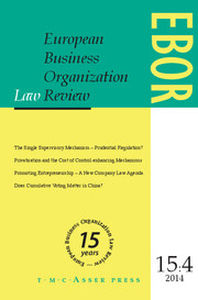Article contents
Legal Approaches to Restricting Distributions to Shareholders: Balance Sheet Tests and Solvency Tests
Published online by Cambridge University Press: 21 June 2006
Abstract
European public company law restricts most distributions by requiring maintenance of a net asset reserve (‘cushion’) of at least the aggregate nominal value of issued shares. This cushion is determined absolutely (without assessment of true values or ongoing solvency by directors, as is permitted in most other jurisdictions) by the latest annual statutory accounts (balance sheet test). An alternative solvency test would require directors to certify sufficiency of assets on an ongoing basis. The amount of the ‘cushion’ is arbitrary (with wide variations between comparable companies and Member States), unrelated to the mischief addressed and thus contrary to general European law principles. EU law establishes four possible balance sheet tests: two (with many variations) under the Fourth Directive (an historic cost and stricter revaluation based test), one (with many variations) under the modernised Fourth Directive, which allows or requires fair value accounting, including the distribution of certain unrealised profits, and one under the International Accounting Standards (IAS) Regulation regime. These tests produce widely divergent results for distributable profits. The Fourth Directive departs markedly from reality and in practice conforms imperfectly with true and fair view principles, the implementation of which varies markedly between Member States. The modernised Fourth Directive and the IAS regimes vary widely according to the options used, confer considerable discretion on company boards and are often very volatile, failing to provide a stable basis for prudential decisions. Prudential regulators have accordingly overridden some of these standards. The results of these tests are diverse, complex, costly, subject to regulatory arbitrage and irrational. Statements designed for financial reporting purposes are inappropriate for setting prudential decisions. The proposed solvency assurance is designed to address the mischief by a proportionate, focused assurance of solvency, with director certification before distributions of liquidity for a year and availability of sufficient assets to meet all liabilities for the foreseeable future – a stricter version of the test currently imposed in the United Kingdom for capital distributions in company reconstructions. Such a test should be adopted as an option throughout the European Union with issues of sanctions and controls being a matter for Member State discretion.
Keywords
- Type
- Articles
- Information
- Copyright
- T.M.C. Asser Press 2006
- 7
- Cited by


